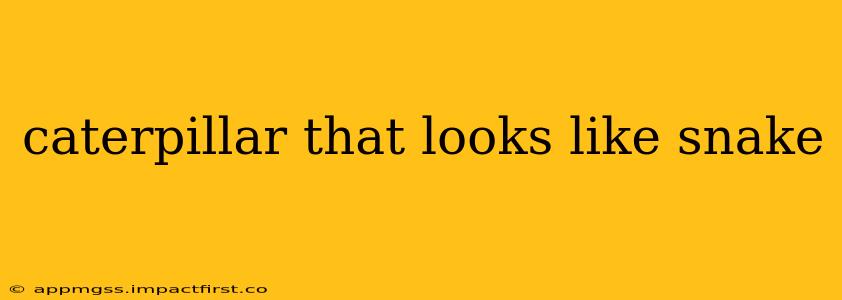Many caterpillars employ remarkable camouflage strategies to survive in the wild. One of the most striking examples is the caterpillar that mimics a snake, a fascinating adaptation that protects them from predators. This isn't just a superficial resemblance; these caterpillars have evolved intricate details to convincingly portray a far more dangerous creature. Let's delve into the world of these deceptive insects and uncover the secrets behind their snake-like appearances.
What Kind of Caterpillar Looks Like a Snake?
Several species of caterpillars exhibit snake-like characteristics, employing a variety of techniques. The specific appearance varies depending on the species and its environment. However, common features include:
- Coloration: Many mimic the colors of venomous snakes found in their habitat. This can range from vibrant greens and browns to striking yellows and blacks, often arranged in patterns that resemble snake scales or markings.
- Shape and Posture: Some caterpillars will coil their bodies to resemble a snake's coiled form, often raising their anterior end to further enhance the illusion. This dramatic posture can be quite startling to potential predators.
- False Eyespots: Many species incorporate false eyespots on their heads or bodies. These large, dark spots further enhance the snake illusion, adding a level of intimidation.
- Appendages: Some caterpillars possess appendages or protrusions that mimic a snake's head or tongue, further completing the deceptive strategy. These may be fleshy or even possess a slightly forked appearance.
How Do Caterpillars Mimic Snakes?
This remarkable mimicry isn't accidental. It's a product of evolution, driven by natural selection. Caterpillars that more effectively resemble snakes have a higher chance of survival and reproduction. Over generations, the traits contributing to the snake-like appearance become more pronounced within the species.
This form of mimicry, known as Batesian mimicry, involves a harmless organism mimicking the warning signals of a harmful one. The caterpillar, being harmless, gains protection by convincing predators it's a venomous snake.
Are Caterpillars That Look Like Snakes Poisonous?
No, caterpillars that mimic snakes are generally not poisonous. Their resemblance to snakes is purely a defensive mechanism. They lack the venom glands or other poisonous apparatus found in actual snakes. Their strategy relies entirely on deception to deter predation.
What Are Some Examples of Snake-Mimicking Caterpillars?
While precise identification requires expert knowledge and often relies on geographical location, several caterpillar families exhibit snake-like characteristics. Researching the specific caterpillars found in your region will yield more accurate results. Remember to never handle caterpillars without appropriate caution and respect for their unique adaptations.
How Can I Identify a Caterpillar That Looks Like a Snake?
Identifying a specific species of snake-mimicking caterpillar requires close observation and careful consideration of its physical characteristics:
- Location: Where was the caterpillar found? Knowing the geographic location will narrow down the possibilities considerably.
- Coloration and Pattern: Carefully note the color and pattern on its body. Are there any distinct markings resembling snake scales or eyespots?
- Size and Shape: How large is the caterpillar? What is the general shape of its body when it is at rest? Does it coil?
- Appendages: Observe any unusual appendages or protrusions on its head or body.
Consulting field guides specific to your region and online resources with images of local caterpillars will greatly assist in identification.
What Should I Do If I Find a Caterpillar That Looks Like a Snake?
Admire it from a safe distance! While generally harmless, it's always best to avoid direct contact with any wild animal, especially caterpillars, as some may possess irritating hairs or other defensive mechanisms. Observe it carefully but resist the urge to handle it. Taking a photograph for later identification is an excellent way to appreciate this incredible example of natural mimicry.
By understanding the remarkable adaptations of caterpillars that resemble snakes, we gain a deeper appreciation for the incredible diversity and ingenuity found in the natural world. Their survival strategy exemplifies the power of evolution and the constant interplay between predator and prey.
